Blade Roughness Effects on Compressor and Engine Performance—A CFD and Thermodynamic Study
Abstract
1. Introduction
2. Roughness Modelling
- (1)
- hydraulically smooth wall: 0 ≤ ≤ 5.
- (2)
- transitional roughness wall: 5 ≤ ≤ 70.
- (3)
- full roughness wall: ≥ 70.
- (1)
- The value of = 5 µm represents a healthy in-service blade.
- (2)
- The value of = 20 µm represents in-service deteriorated blade.
- (3)
- The value = 40 µm represents in-service completely rough blade surface.
3. Computational Approach
3.1. Model Description
3.2. Mesh Generation and Model Verification
3.3. Boundary Conditions and Convergence Criterium
- (1)
- The stator domains of the EGV, IGV, S2, and S3 were set as stationary.
- (2)
- The rotor domains of the fan, R2, and R3 were set as rotating at 4215 rpm.
- (3)
- All walls were set as no slip.
- (4)
- At the inlet: the stationary frame total pressure = 101.325 KPa, and total temperature = 288.15 K were prescribed. The turbulence intensity was set at 5%.
- (5)
- Mixing planes were used as the interface between stator and rotor rows.
- (6)
- At outlets, bypass and booster, average static pressure was specified with values adjusted by trial and error to enable these two components to pass the target .
3.4. CFD Results Comparison
4. Results and Discussion
4.1. Effect of Roughness Variation on Engine Mass Flow
4.2. Effect of Roughness Variation on Compressor Aerodynamics
4.2.1. Effect on Flow Structure
4.2.2. Effect on Mach Number Distributions
4.2.3. Effect on Total Pressure
4.2.4. Distribution of Axial Velocity
4.2.5. The Pressure Coefficient
4.3. Turbomatch Performance Tool
Turbomatch Model Validation
4.4. Turbomatch Performance Results
4.4.1. Effect on Compressor Maps
4.4.2. Effect on Cycle Parameters
5. Conclusions
- The simulations employed uniformly roughened blades notwithstanding the fact that it is known that rotor and stator blades experience different levels of roughness in the suction and pressure sides when compressors are exposed to SPE conditions. This modelling approach is justified on the grounds that the pressure side of both stators and rotors is largely insensitive to the variation in whole blade roughness level as is evident from the analysis of Figure 13.
- The increase in surface roughness of the first two stages of the LPC results in a quantifiable reduction in the performance variables of the research engine studied. The examined performance variables, isentropic efficiency, LPC PR, NDMF, TET, SFC, and overall PR exhibited, for the maximum blade surface degradation case, drops of 7.68%, 2.62% and 3.53%, rises of 1.14% and 0.69%, and a drop of 0.86%, respectively.
- The maximum blade roughness results represent an extreme case, examined out of academic enquiry, since according to the literature, the SPE induced roughness level tends to stabilise independently of the erosion duration at around the 60 µm mark. The variation in the same parameters recorded above for this level of roughness, in terms of LPC PR, isentropic efficiency, NDMF, TET, SFC, and overall PR, corresponds to a drop of 1.85%, 5.92%, 2.72%, and increases of 0.81% and 0.51%, together with a drop of 0.63%, respectively.
- The effect of increasing roughness on the LPC maps is characterised by the shift towards lower PR and NDMF values. The variation is more marked between the smooth and Rough 1 roughness regimes when compared to further roughness values. This observation has two aspects. Turbomachinery designers need to account for the operation of low pressure compressors used in propulsive applications to include the effects of a finite amount of roughness, which is an unavoidable consequence of their employment in eroding atmospheric environments. The second aspect relates to the physics of the erosion phenomenon, which limits the upper threshold of roughness of the blades and represents, therefore, a well-defined, worst-case scenario.
- Although the various roughness levels examined were applied uniformly over the blades of the first two stages of the LPC, the SS region, as well as the early chordwise locations, exhibit the greatest variation, with reference to the smooth case in terms of chordwise coefficient. These regions are most effective at promoting the thickening of the local boundary layers, as evidenced through the total pressure distributions downstream of the blades as well as the pitchwise distribution of axial velocity.
Author Contributions
Funding
Institutional Review Board Statement
Informed Consent Statement
Acknowledgments
Conflicts of Interest
Nomenclature
| Total pressure loss coefficient | |
| Log-layer constant | |
| DP | Design point |
| Approximate relative error | |
| Extrapolated relative error | |
| Fine-grid convergence index | |
| h | Cell size |
| HPC | High pressure compressor |
| HPT | High pressure turbine |
| k | Von Karman constant |
| Equivalent sand-grain size (µm) | |
| Modified sand-grain roughness (µm) | |
| LE | Leading edge of the blade |
| LPC | Low pressure compressor |
| LPT | Low pressure turbine |
| Mass flow rate (kg/s) | |
| Mass flow at inlet (kg/s) | |
| NDMF | Non-dimensional mass flow |
| 1,2, | Total number of cells |
| Static pressure (Pa) | |
| Total pressure (Pa) | |
| PR | Pressure ratio |
| PS | Pressure side |
| RANS | Reynolds Averaged Navier Stokes |
| Mean roughness (µm) | |
| Reynolds number | |
| Roughness Reynolds number | |
| Grid refinement factor | |
| SF | Scaling factor |
| Scaling factor of the PR | |
| Scaling factor of the NDMF | |
| Scaling factor of the isentropic efficiency | |
| SFC | Specific fuel consumption (g/kN.s) |
| SS | Suction side |
| TE | Trailing edge of the blade |
| TET | Turbine entry temperature (K) |
| Total temperature (K) | |
| Velocity parallel to the wall (m/s) | |
| Dimensionless velocity | |
| Friction velocity (m/s) | |
| Modified friction velocity (m/s) | |
| v | Kinematic viscosity (N.s/m2) |
| Relative inlet velocity (m/s) | |
| Dimensionless distance from the wall | |
| Modified dimensionless distance from the wall | |
| Greek letters | |
| ρ | Density (kg/m3) |
| Wall shear stress (Pa) | |
| Isentropic efficiency | |
| Cells volume (m3) | |
| Pressure ratio (PR) values | |
| Extrapolated value | |
References
- Szwaba, R.; Kaczynski, P.; Doerffer, P. Roughness effect on shock wave boundary layer interaction area in compressor fan blades passage. Aerosp. Sci. Technol. 2019, 85, 171–179. [Google Scholar] [CrossRef]
- Smil, V. The two prime movers of globalization: History and impact of diesel engines and gas turbines. J. Glob. Hist. 2007, 2, 373–394. [Google Scholar] [CrossRef][Green Version]
- Alsayegh, A.; Ali, N. Gas turbine intercoolers: Introducing nanofluids—A mini-review. Processes 2020, 8, 1572. [Google Scholar] [CrossRef]
- Hu, J.; Wang, R.; Huang, D. Improvements of performance and stability of a single-stage transonic axial compressor using a combined flow control approach. Aerosp. Sci. Technol. 2019, 86, 283–295. [Google Scholar] [CrossRef]
- Alqallaf, J.; Ali, N.; Teixeira, J.A.; Addali, A. Solid particle erosion behaviour and protective coatings for gas turbine compressor blades-A review. Processes 2020, 8, 984. [Google Scholar] [CrossRef]
- Diakunchak, I.S. Performance deterioration in industrial gas turbines. Proc. ASME Turbo Expo. 1991, 4, 161–168. [Google Scholar]
- Brun, K.; Kurz, R.; Simmons, H.R. Aerodynamic instability and life-limiting effects of inlet and interstage water injection into gas turbines. J. Eng. Gas Turbines Power 2006, 128, 617–625. [Google Scholar] [CrossRef]
- Liu, C.; Cao, Y.; Ding, S.; Zhang, W. Effects of blade surface roughness on compressor performance and tonal noise emission in a marine diesel engine turbocharger. Proc. Inst. Mech. Eng. Part D J. Automob. Eng. 2020, 234, 3476–3490. [Google Scholar] [CrossRef]
- Ali, N.; Teixeira, J.A.; Addali, A.; Al-Zubi, F.; Shaban, E.; Behbehani, I. The effect of aluminium nanocoating and water pH value on the wettability behavior of an aluminium surface. Appl. Surf. Sci. 2018, 443, 24–30. [Google Scholar] [CrossRef]
- Ali, N.; Teixeira, J.A.; Addali, A.; Saeed, M.; Al-Zubi, F.; Sedaghat, A.; Bahzad, H. Deposition of stainless steel thin films: An electron beam physical vapour deposition approach. Materials 2019, 12, 571. [Google Scholar] [CrossRef]
- Ali, N.; Teixeira, J.A.; Addali, A. Effect of water temperature, ph value, and film thickness on the wettability behaviour of copper surfaces coated with copper using eb-pvd technique. J. Nano Res. 2019, 60, 124–141. [Google Scholar] [CrossRef]
- Burberi, C.; Michelassi, V.; Scotti Del Greco, A.; Lorusso, S.; Tapinassi, L.; Marconcini, M.; Pacciani, R. Validation of steady and unsteady CFD strategies in the design of axial compressors for gas turbine engines. Aerosp. Sci. Technol. 2020, 107, 106307. [Google Scholar] [CrossRef]
- Sun, S.; Wang, S.; Zhang, L.; Ji, L. Design and performance analysis of a two-stage transonic low-reaction counter-rotating aspirated fan/compressor with inlet counter-swirl. Aerosp. Sci. Technol. 2021, 111, 106519. [Google Scholar] [CrossRef]
- Kubacki, S.; Simoni, D.; Lengani, D.; Dick, E. An Extended Version of an Algebraic Intermittency Model for Prediction of Separation-Induced Transition at Elevated Free-Stream Turbulence Level. Int. J. Turbomach. Propuls. Power 2020, 5, 28. [Google Scholar] [CrossRef]
- Denton, J.D. Loss Mechanisms in Turbomachines; American Society of Mechanical Engineers: New York, NY, USA, 1993; Volume 78897, pp. 1–40. [Google Scholar]
- Hobson, G.V.; Millsaps, K.T.; Song, S.; Millsaps, K. Effects of Reynolds Number and Surface Roughness Magnitude and Location on Compressor Cascade Performance. J. Turbomach. 2012, 134, 051013. [Google Scholar]
- Melino, F.; Morini, M.; Peretto, A.; Pinelli, M.; Spina, P.R. Compressor fouling modeling: Relationship between computational roughness and gas turbine operation time. J. Eng. Gas Turbines Power 2012, 134, 052401. [Google Scholar] [CrossRef]
- Seehausen, H.; Gilge, P.; Kellersmann, A.; Friedrichs, J.; Herbst, F. Numerical Study of Stage Roughness Variations in a High Pressure Compressor. Int. J. Gas Turbine Propuls. Power Syst. 2020, 11, 16–25. [Google Scholar] [CrossRef]
- Pan, T.; Wu, W.; Li, Q. Effect of casing treatment to switch the type of instability inception in a high-speed axial compressor. Aerosp. Sci. Technol. 2021, 115, 106801. [Google Scholar]
- Hamed, A.; Tabakoff, W.; Wenglarz, R. Erosion and deposition in turbomachinery. J. Propuls. Power 2006, 22, 350–360. [Google Scholar] [CrossRef]
- Bammert, K.; Woelk, U.G. Influence of the Blading Surface Roughness on the Aerodynamic Behavior and Characteristic of an Axial Compressor. ASME Pap. 1979, 102, 283–287. [Google Scholar] [CrossRef]
- Zhihui, L.; Yanming, L. Optimization of rough transonic axial compressor. Aerosp. Sci. Technol. 2018, 78, 12–25. [Google Scholar]
- El-Sayed, A. Aircraft Propulsion And Gas Turbine Engines, 2nd ed.; Taylor & Francis Group: London, UK, 2017. [Google Scholar]
- Wang, M.; Yang, C.; Li, Z.; Zhao, S.; Zhang, Y.; Lu, X. Effects of surface roughness on the aerodynamic performance of a high subsonic compressor airfoil at low Reynolds number. Chin. J. Aeronaut. 2020, 34, 1–11. [Google Scholar] [CrossRef]
- Back, S.C.; Sohn, J.H.; Song, S.J. Impact of surface roughness on compressor cascade performance. J. Fluids Eng. Trans. ASME 2010, 132, 0645021–0645026. [Google Scholar] [CrossRef]
- Sun, H.O.; Ma, J.; Wang, Z.; Cao, L. The research on compressor performance degradation caused by surface roughness enlargement due to corrosion in marine environments. Proc. ASME Turbo Expo. 2019, 1, V001T25A003. [Google Scholar]
- Gray, D.; Et, A. NASA: Energy Efficient Engine Preliminary Design and Integration Studies Report; NASA: Hampton, VA, USA, 1978.
- Michael, C.J.; Halle, J.E. NASA: Energy Efficient Engine Low-Pressure Component Test Hardware Detailed Design Report; NASA: Hampton, VA, USA, 1981.
- Halle, J.; Michael, C.J. NASA: Energy Efficient Engine Fan Component Detailed Design Report; NASA: Hampton, VA, USA, 1981.
- Liu, Z.; Zhao, Y.; Chen, S.; Yan, C.; Cai, F. Predicting distributed roughness induced transition with a four-equation laminar kinetic energy transition model. Aerosp. Sci. Technol. 2020, 99, 105736. [Google Scholar] [CrossRef]
- ANSYS. ANSYS CFX-Solver Theory Guide; ANSYS: Canonsburg, PA, USA, 2016; pp. 1–350. [Google Scholar]
- Saidi, N.; Cerdoun, M.; Khalfallah, S.; Belmrabet, T. Numerical investigation of the surface roughness effects on the subsonic flow around a circular cone-cylinder. Aerosp. Sci. Technol. 2020, 107, 106271. [Google Scholar] [CrossRef]
- Launder, B.; Spalding, D. The Numerical Computation of Turbulent flows. Comput. Methods Appl. Mech. Eng. 1973, 3, 269–289. [Google Scholar] [CrossRef]
- Yang, L.; Zhou, J.; Fan, S.; Zheng, Q.; Zhang, H. Method and numerical simulation for evaluating the effects of water film on the performance of low-speed axial compressor. Aerosp. Sci. Technol. 2019, 84, 306–317. [Google Scholar] [CrossRef]
- Liu, C.; Shi, Y.; Cao, Y. Numerical study of effects of blade fouling on compressor performance and tonal noise emission. Aiaa Aviat. Forum 2020, 2699, 1–14. [Google Scholar]
- Li, Z.; Liu, Y. Effect of end-wall roughness on performance of transonic axial compressor. Proc. Inst. Mech. Eng. Part G J. Aerosp. Eng. 2017, 231, 1213–1224. [Google Scholar] [CrossRef]
- Syverud, E.; Bakken, L.E. The Impact of Surface Roughness on Axial Compressor Performance Deterioration. ASME Turbo Expo Power Land Sea Air 2006, 42401, 491–501. [Google Scholar]
- Aldi, N.; Morini, M.; Pinelli, M.; Spina, P.R.; Suman, A.; Venturini, M. Performance evaluation of nonuniformly fouled axial compressor stages by means of computational fluid dynamics analyses. J. Turbomach. 2014, 136, 1–11. [Google Scholar] [CrossRef]
- Zaita, A.V.; Butey, G.; Karlsons, G. Performance deterioration modeling in aircraft gas turbine engines. Proc. ASME Turbo Expo. 1998, 120, 4. [Google Scholar] [CrossRef]
- Celik, I.B.; Ghia, U.; Roache, P.J.; Freitas, C.J.; Coleman, H.; Raad, P.E. Procedure for estimation and reporting of uncertainty due to discretization in CFD applications. J. Fluids Eng. Trans. ASME 2008, 130, 0780011–0780014. [Google Scholar]
- Boyce, M.P. Principles Of Operation And Performance Estimation Of Centrifugal Compressors. In Proceedings of the 22nd Turbomachinery Symposium, College Station, TX, USA, 14–16 September 1993; pp. 161–178. [Google Scholar]
- Boyce, M.P. Gas Turbine Engineering Handbook, 2nd ed.; Gulf Professional Publishing: Oxford, UK, 2002; Volume 134. [Google Scholar]
- Zhang, Q.; Ligrani, P.M. Aerodynamic losses of a cambered turbine vane: Influences of surface roughness and freestream turbulence intensity. J. Turbomach. 2006, 128, 536–546. [Google Scholar] [CrossRef]
- Suder, K.L.; Chima, R.V.; Strazisar, A.J.; Roberts, W.B. The Effect of Adding Roughness and Thickness to a Transonic Axial Compressor Rotor. In Proceedings of the 39th International Gas Turbine and Aeroengine Congress and Exposition sponsored by the American Society of Mechanical Engineers, The Hague, The Netherlands, 13–16 June 1994; pp. 491–505. [Google Scholar]
- Sun, J.; Ottavy, X.; Liu, Y.; Lu, L. Corner separation control by optimizing blade end slots in a linear compressor cascade. Aerosp. Sci. Technol. 2021, 114, 106737. [Google Scholar] [CrossRef]
- De Giorgi, M.G.; Quarta, M. Hybrid MultiGene Genetic Programmin—Artificial neural networks approach for dynamic performance prediction of an aeroengine. Aerosp. Sci. Technol. 2020, 103, 105902. [Google Scholar] [CrossRef]
- Zhang, J.; Tang, H.; Chen, M. Robust design of an adaptive cycle engine performance under component performance uncertainty. Aerosp. Sci. Technol. 2021, 113, 106704. [Google Scholar] [CrossRef]
- Gallar, L.; Volpe, V.; Salussolia, M.; Pachidis, V.; Jackson, A. Thermodynamic gas model effect on gas turbine performance simulations. J. Propuls. Power 2012, 28, 719–727. [Google Scholar] [CrossRef]
- Suresh, S.; Nikolaidis, T.; Pilidis, P. TURBOMATCH-webengine—A web based gas turbine engine performance analysis tool. ASME Turbo Expo. 2013, 55188, 1–8. [Google Scholar]
- Nind, A.; Sethi, V.; Sampath, S. Towards the Development of A Technoeconomic, Environmental Risk Analysis for an Aircraft Operator, Awatef Hamed; Faculty Work and Research, College of Engineering and Applied Science: Cincinnati, OH, USA, 2015. [Google Scholar]
- Igie, U.; Abbondanza, M.; Szymański, A.; Nikolaidis, T. Impact of compressed air energy storage demands on gas turbine performance. Proc. Inst. Mech. Eng. Part A J. Power Energy 2020. [Google Scholar] [CrossRef]
- Meher-Homji, C.; Bromley, A. Gas Turbine Axial Compressor Fouling and Washing. Turbomach. Symp. 2004, 163–191. [Google Scholar] [CrossRef]
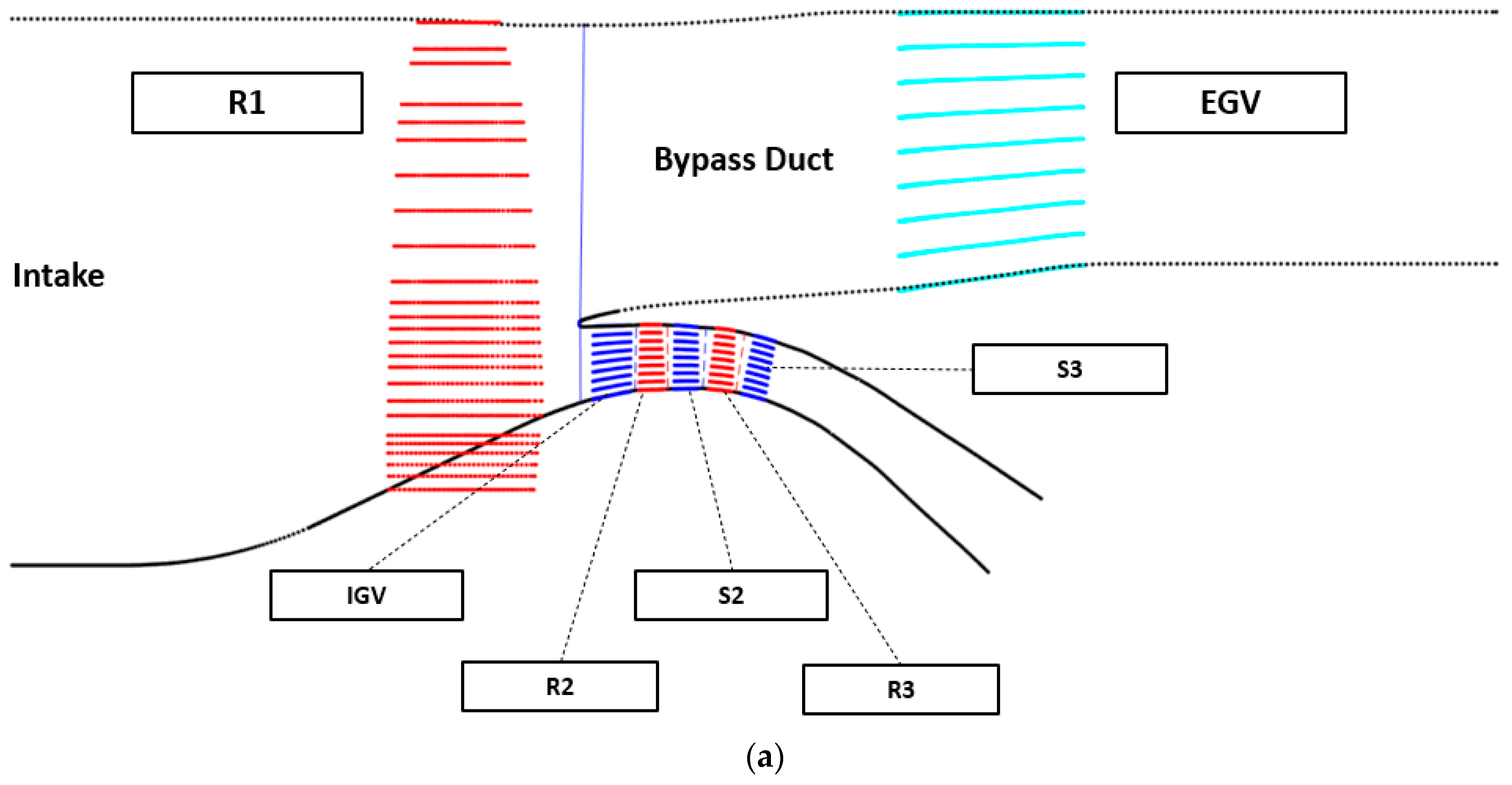

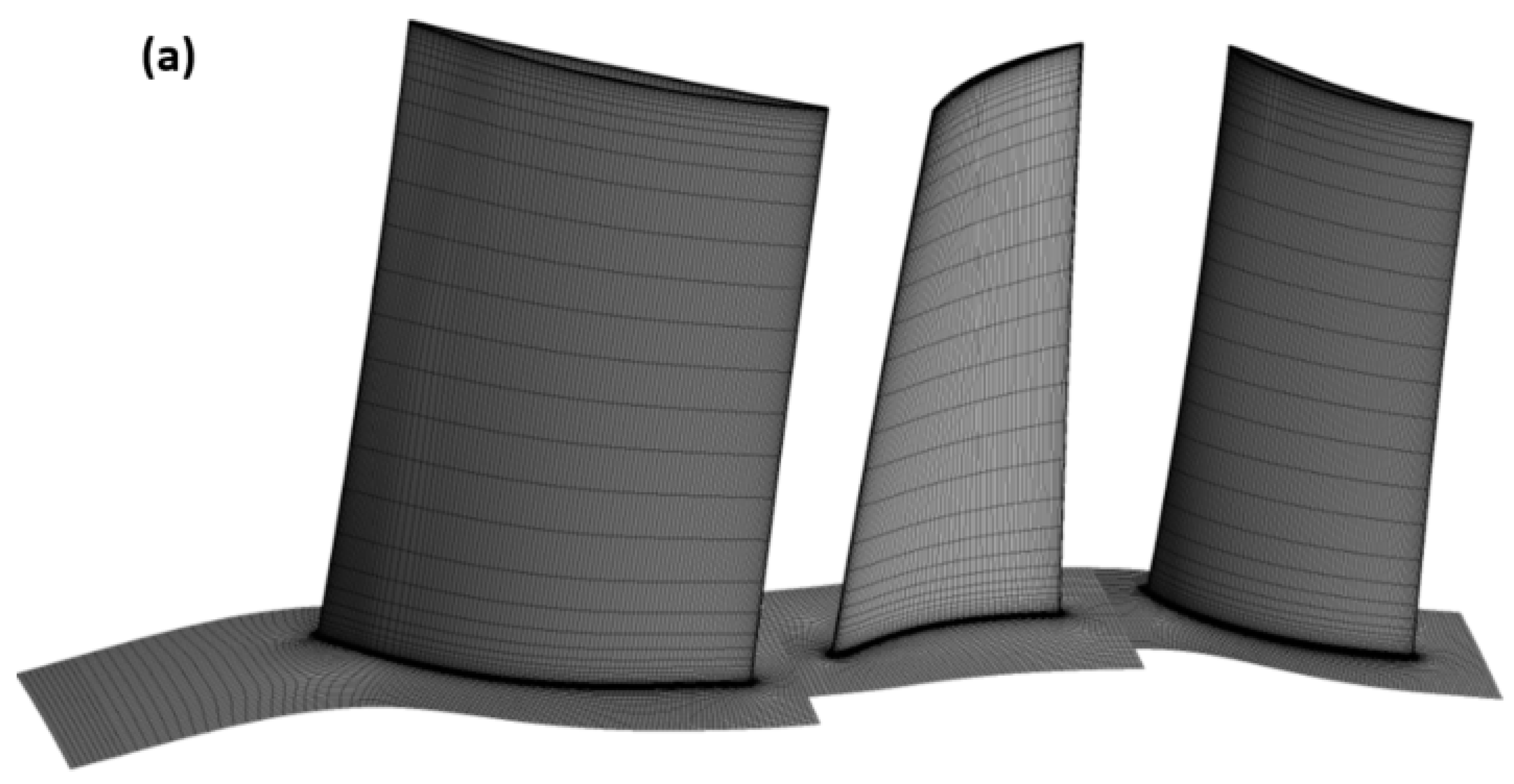
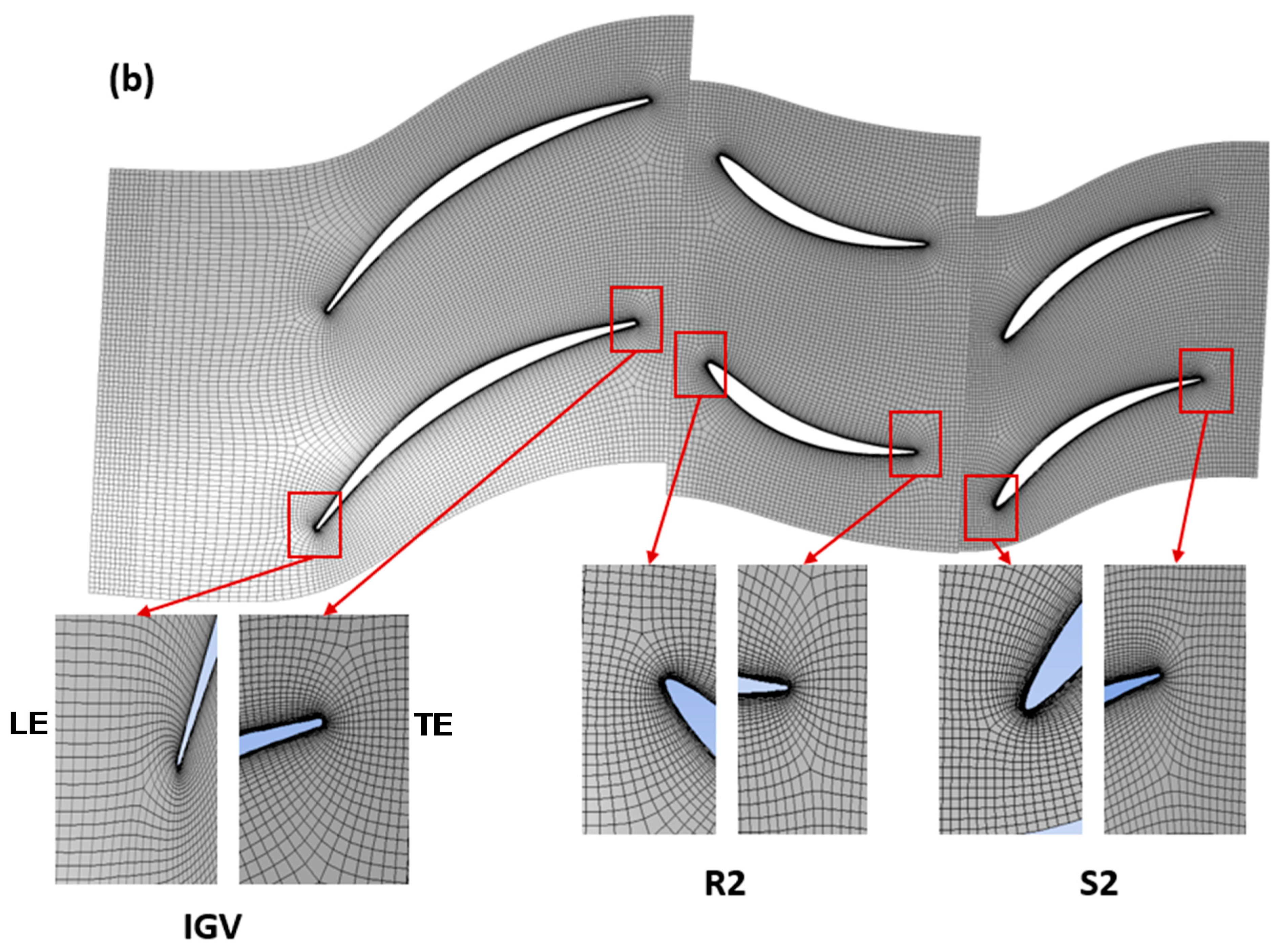
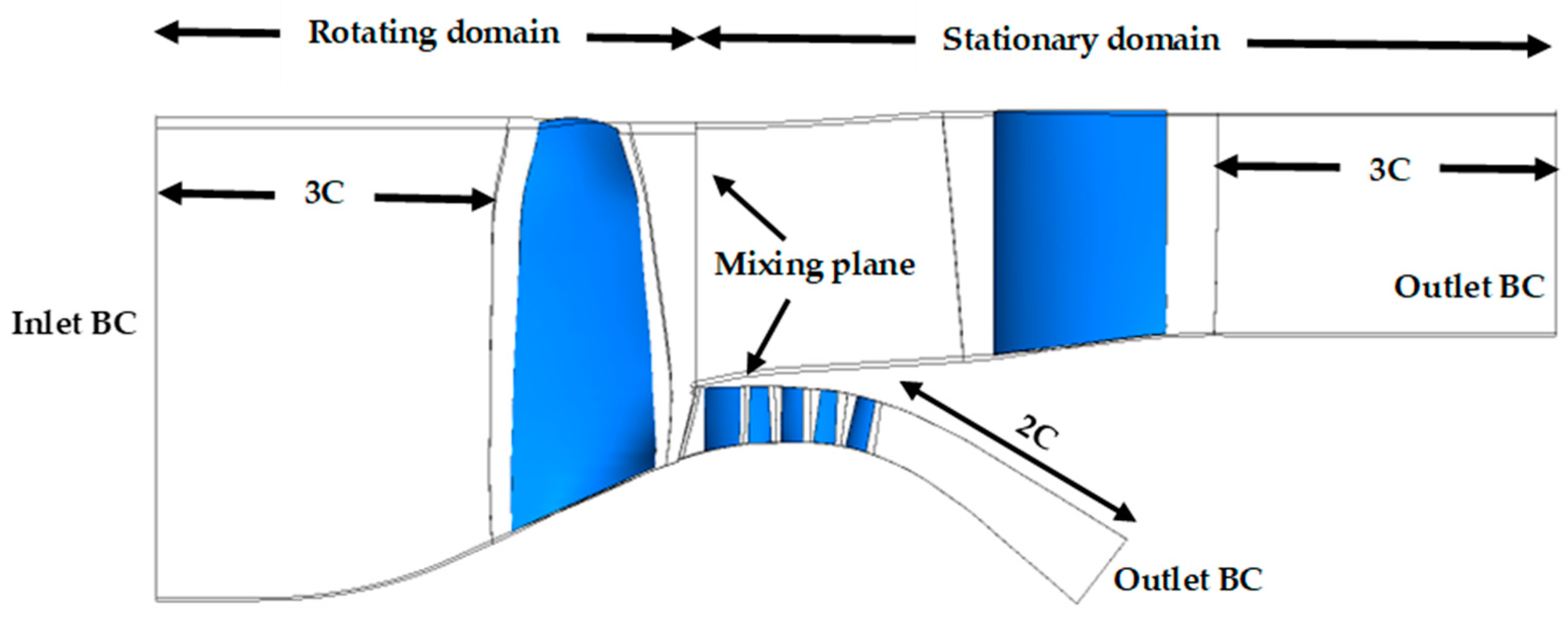
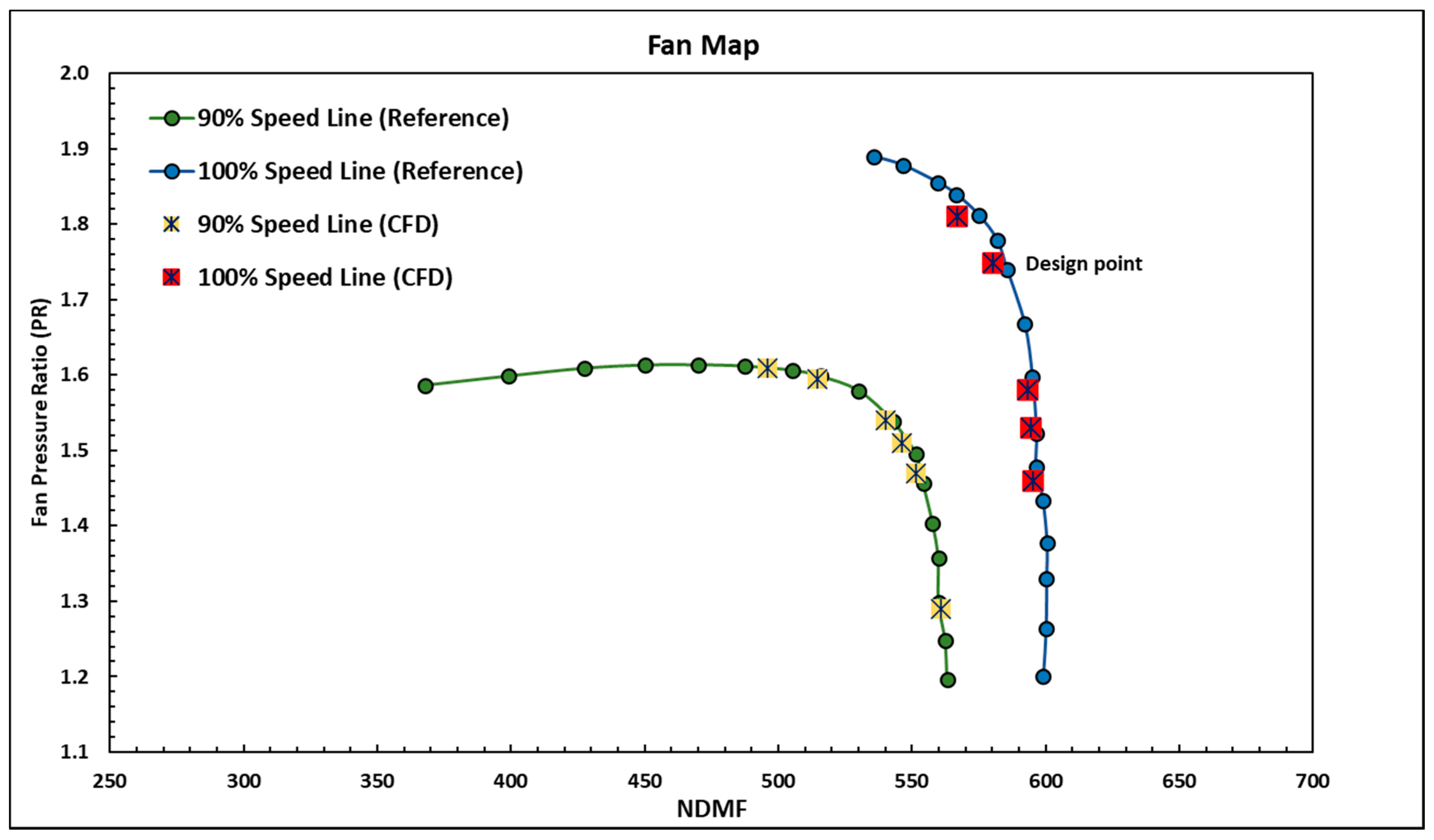
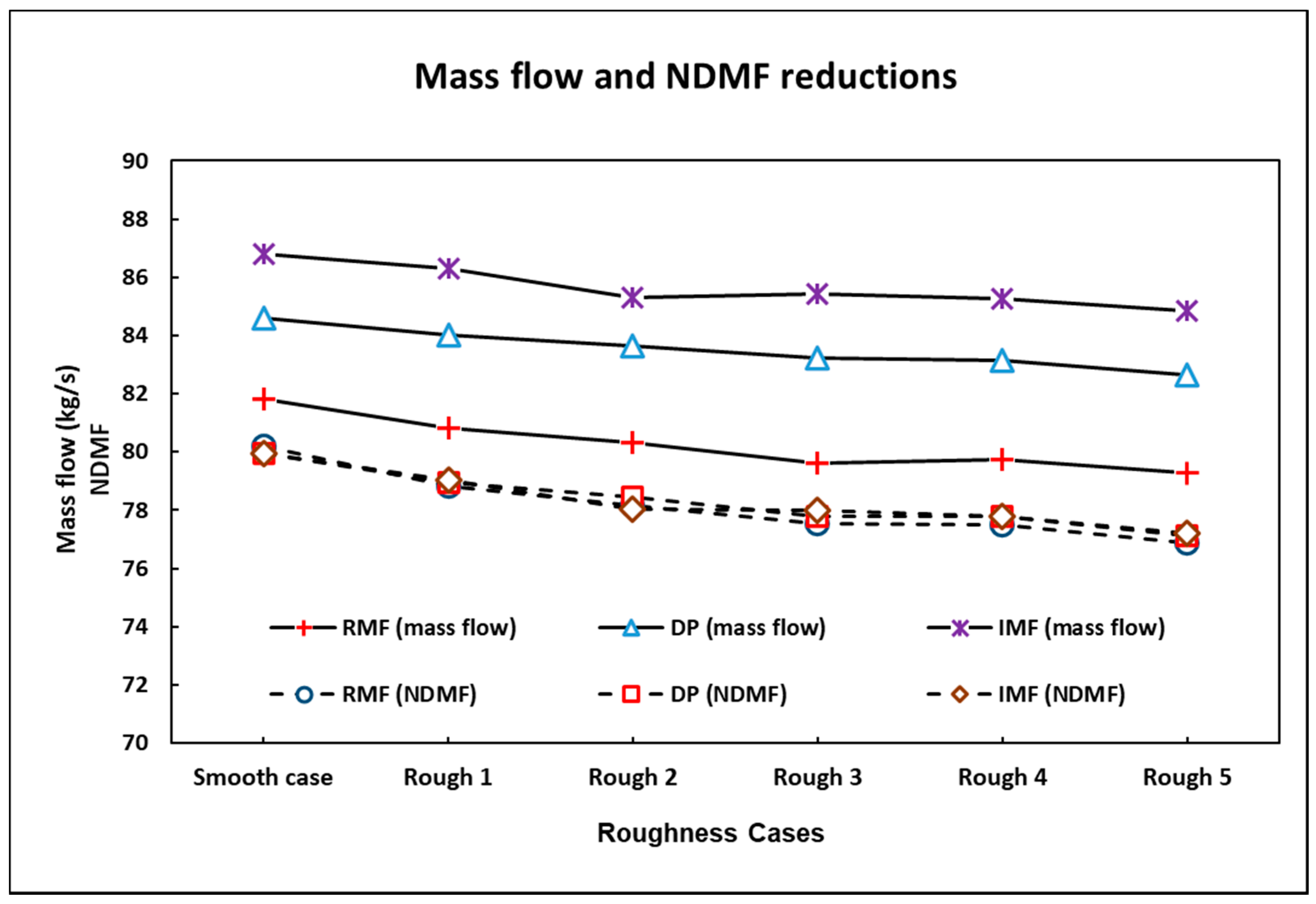
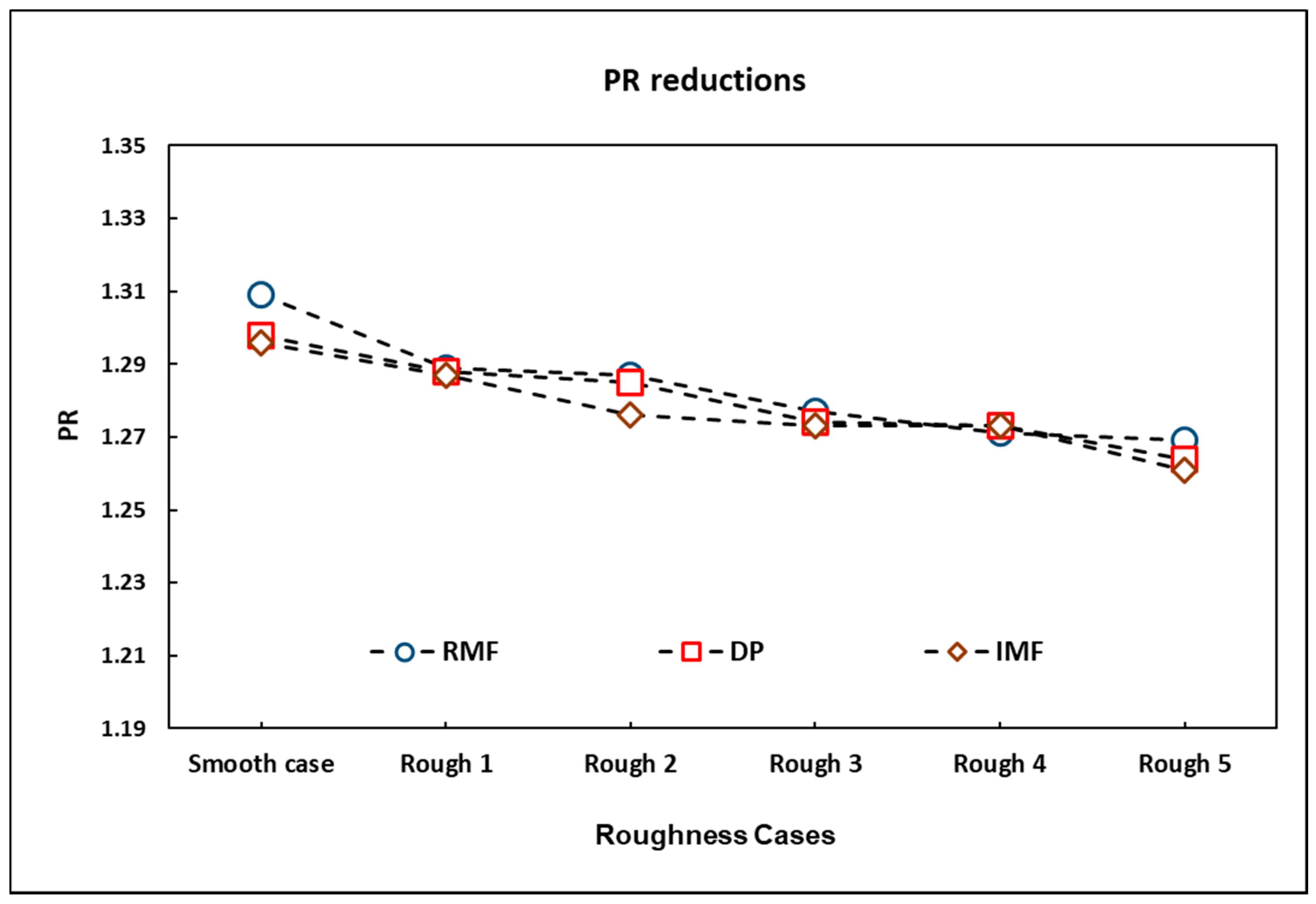

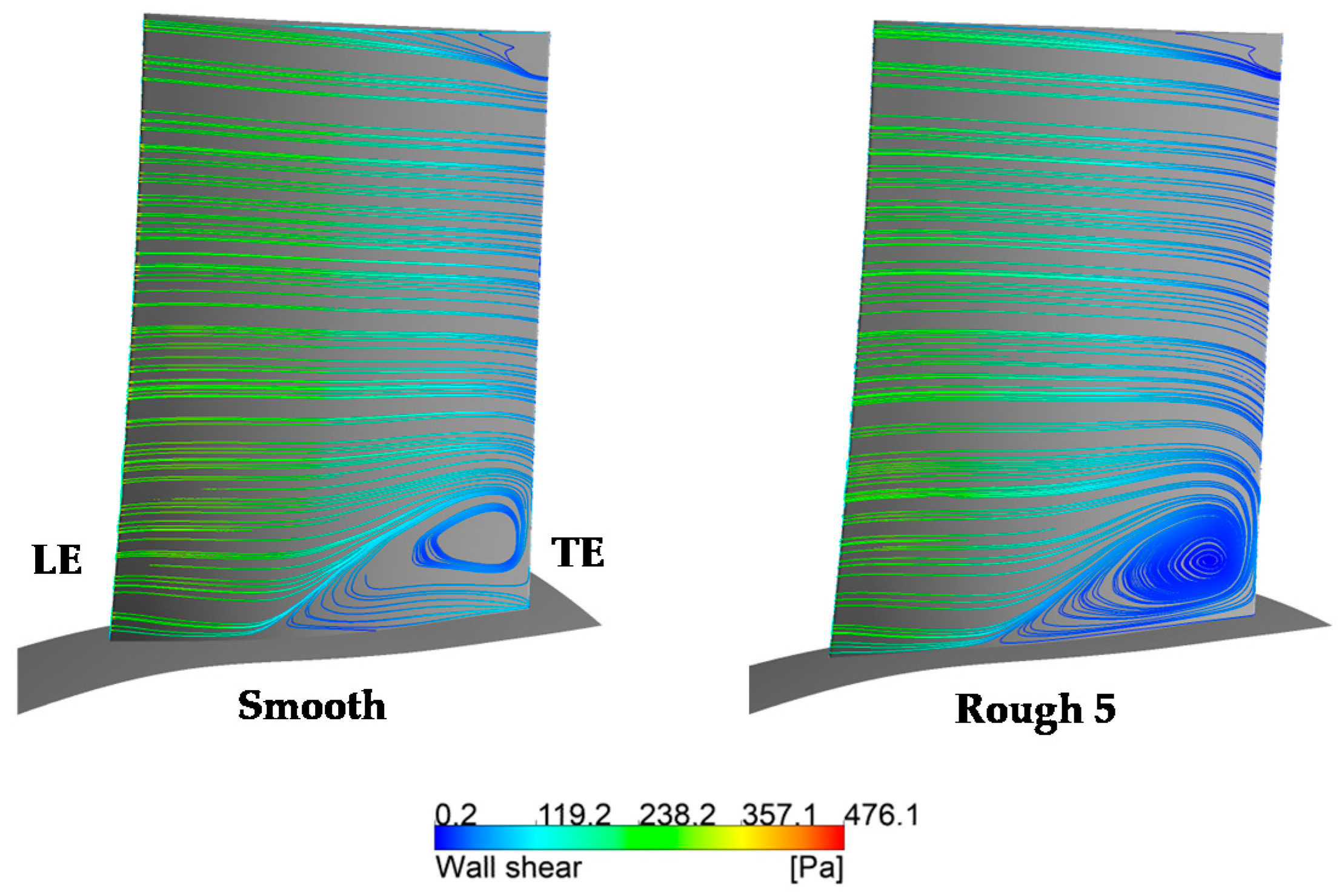
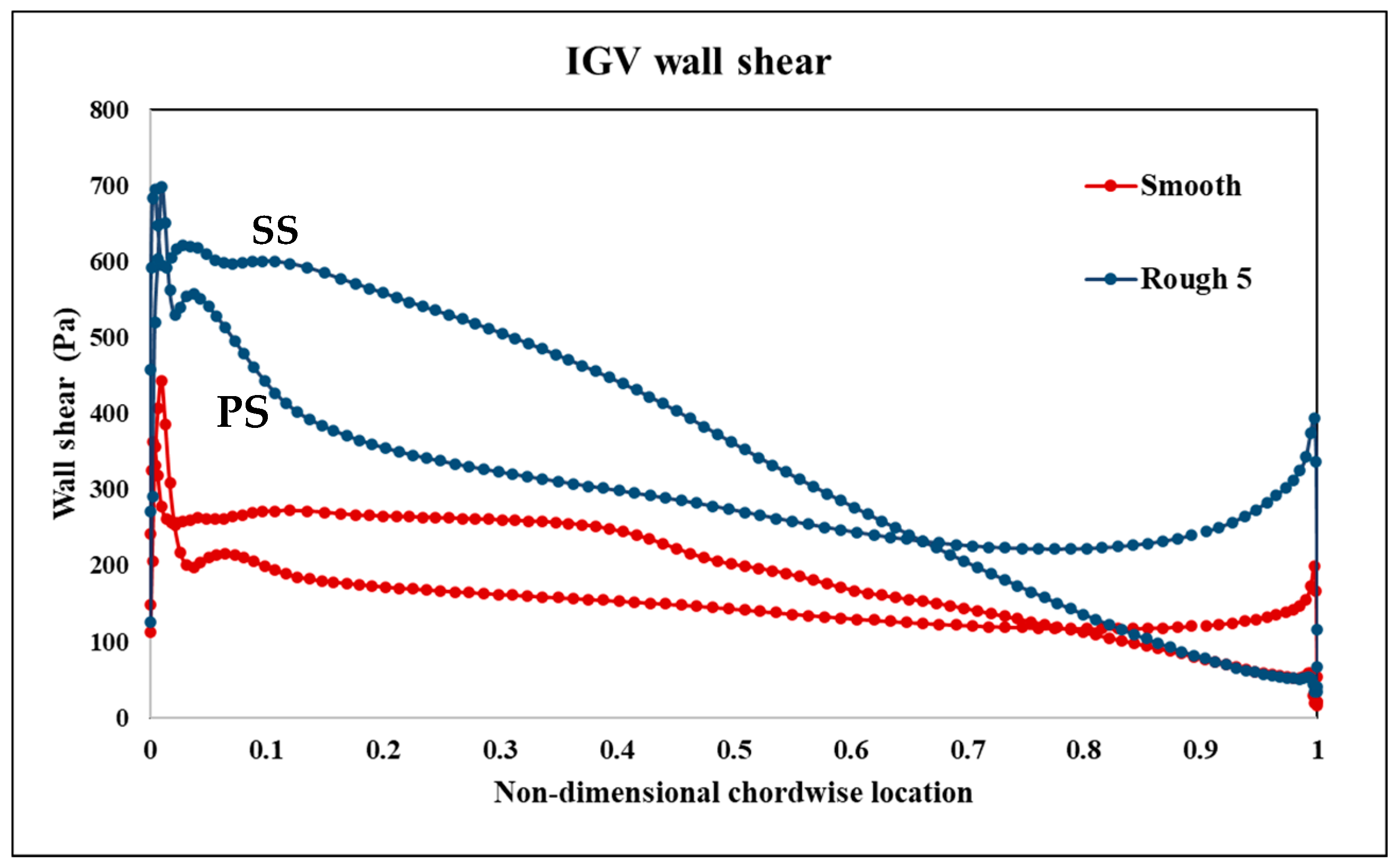
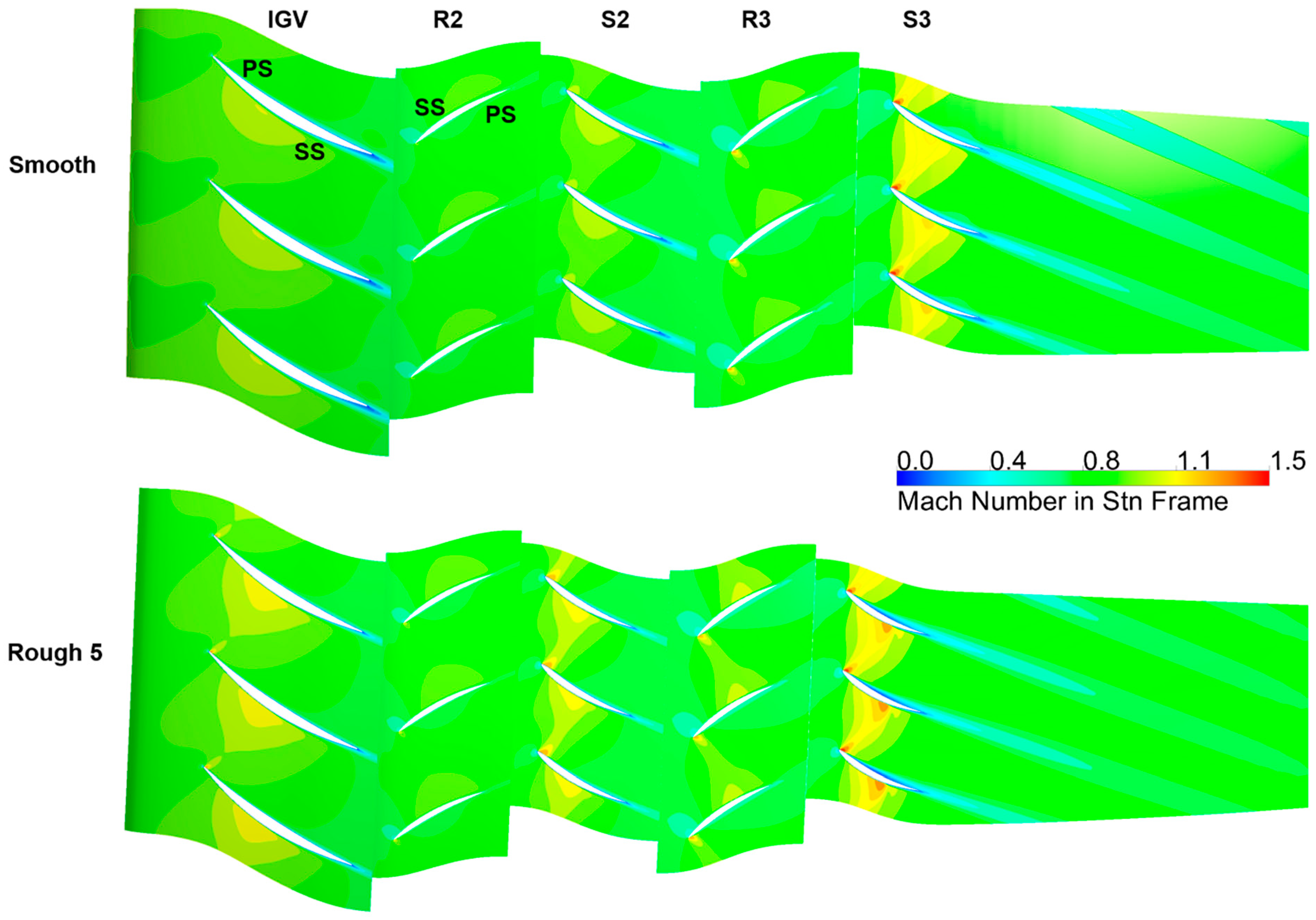
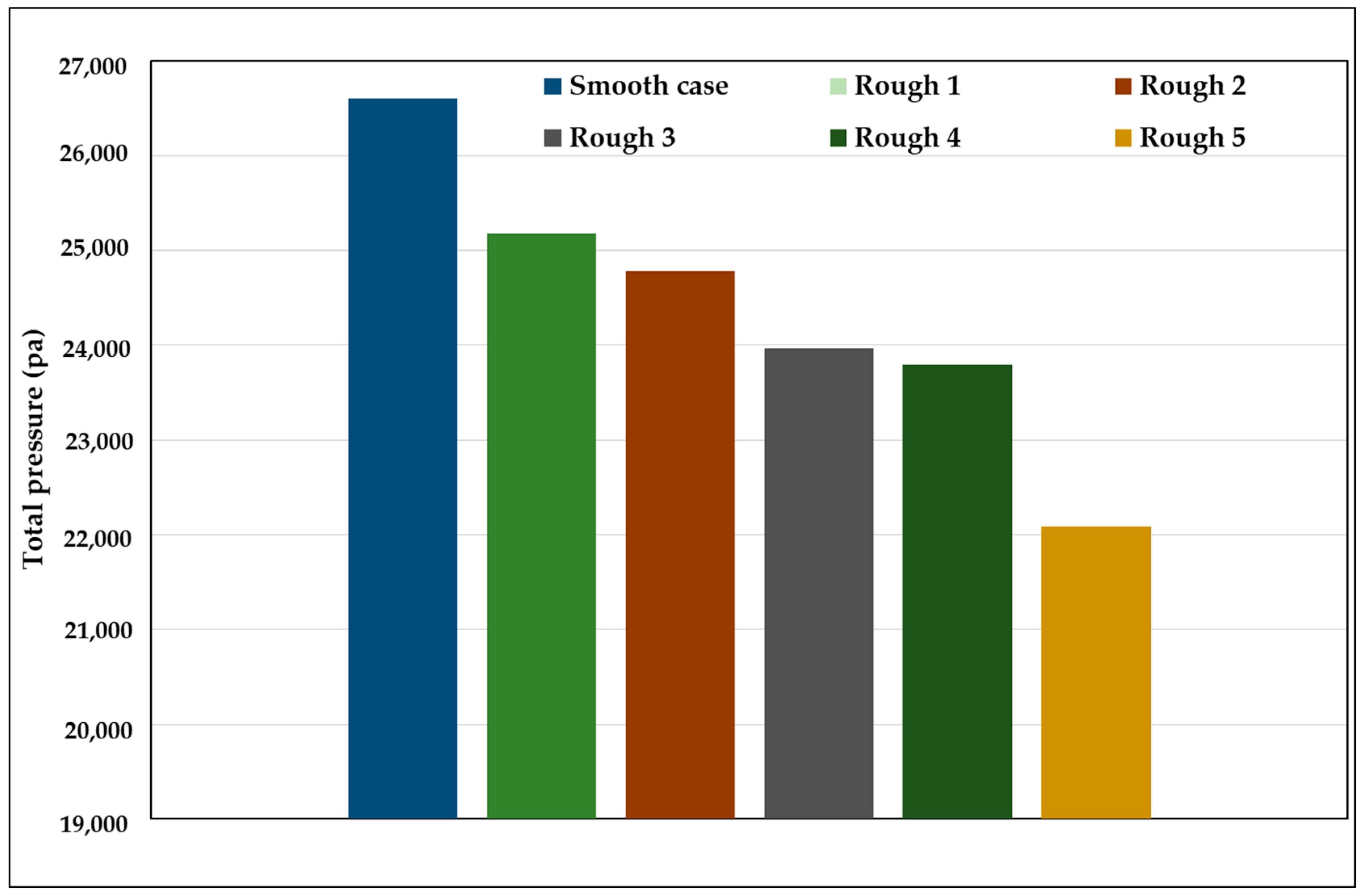
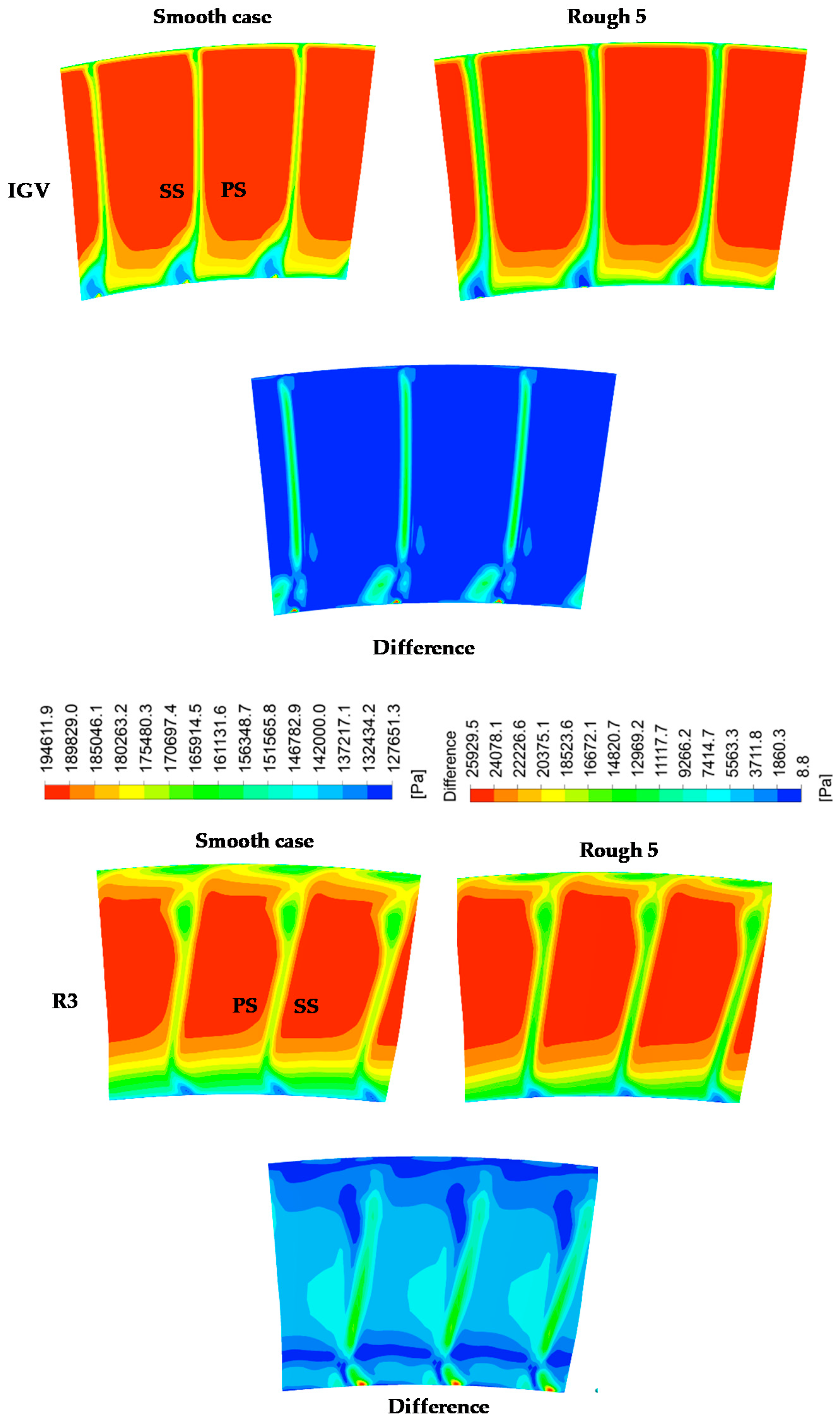
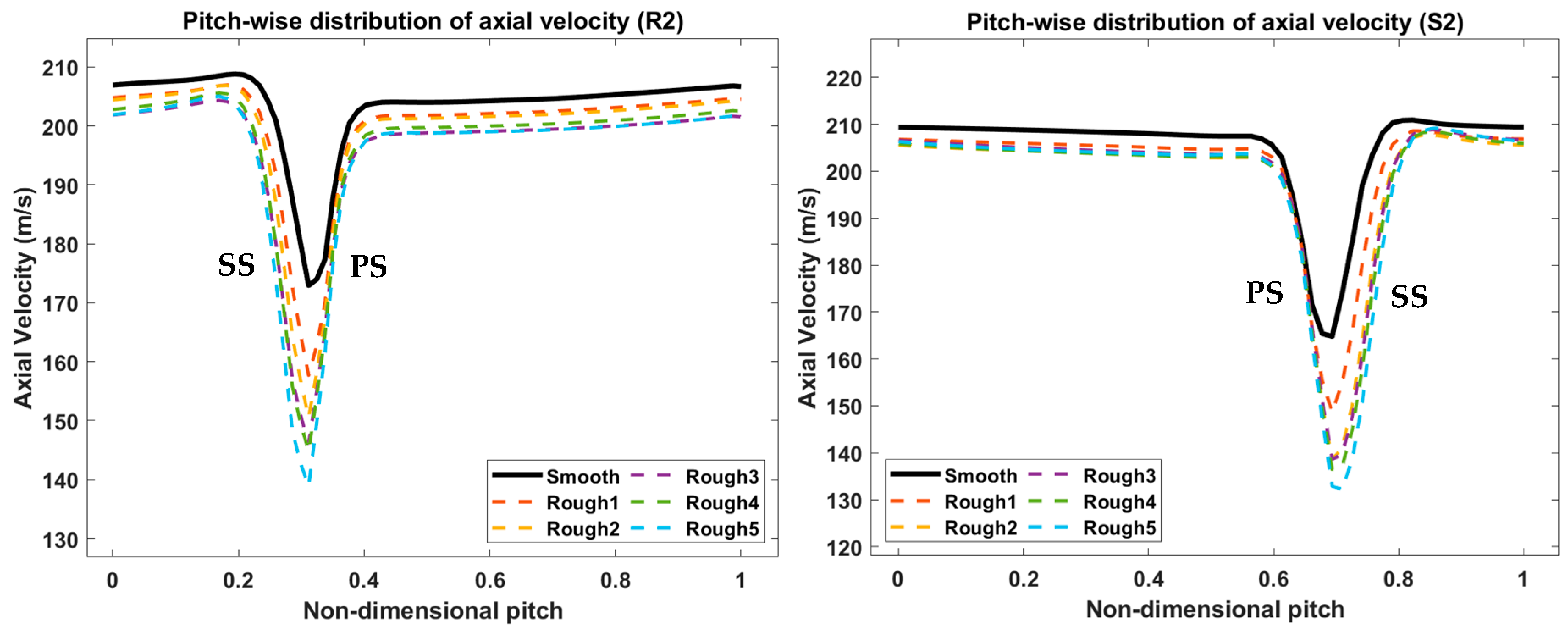
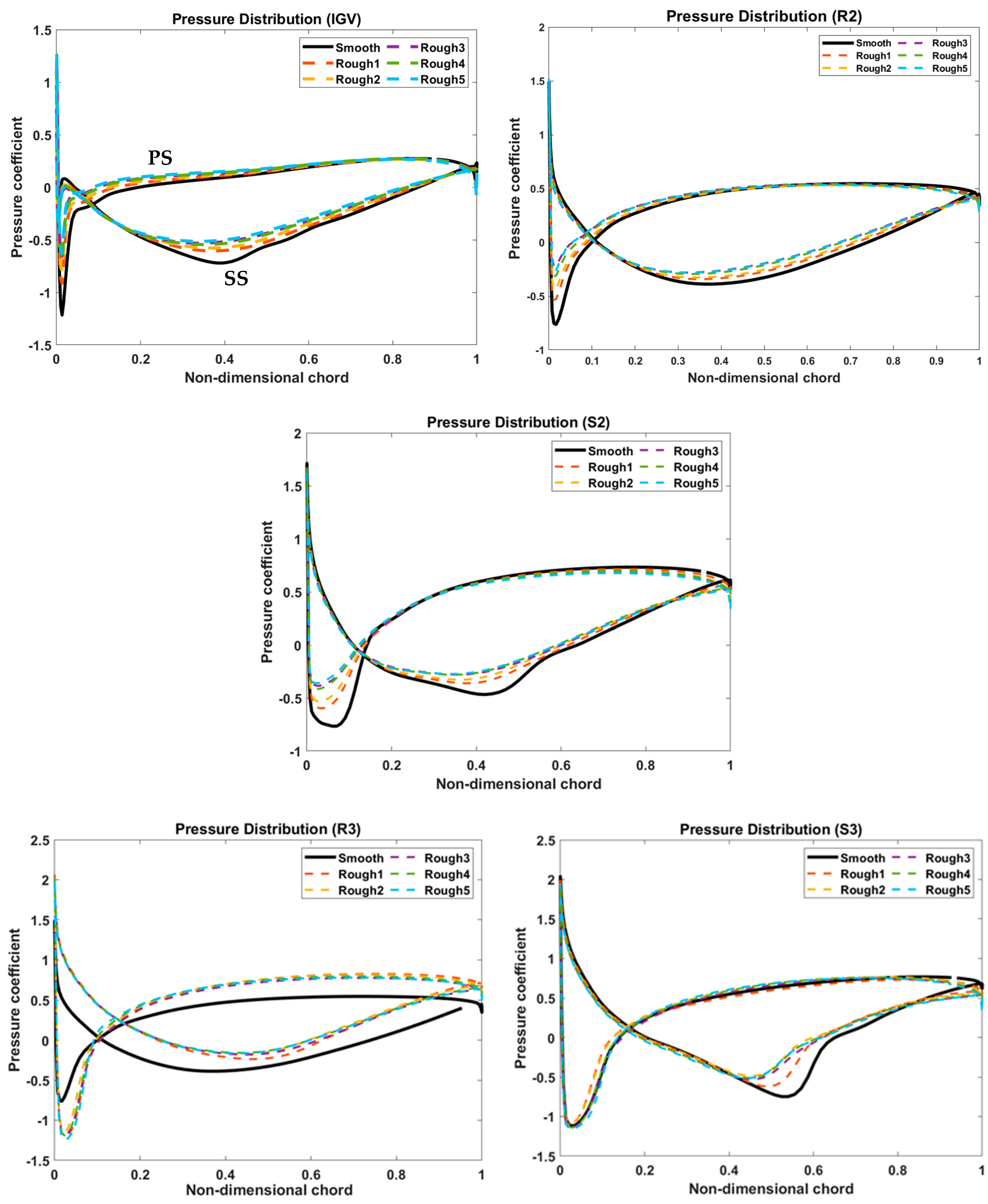
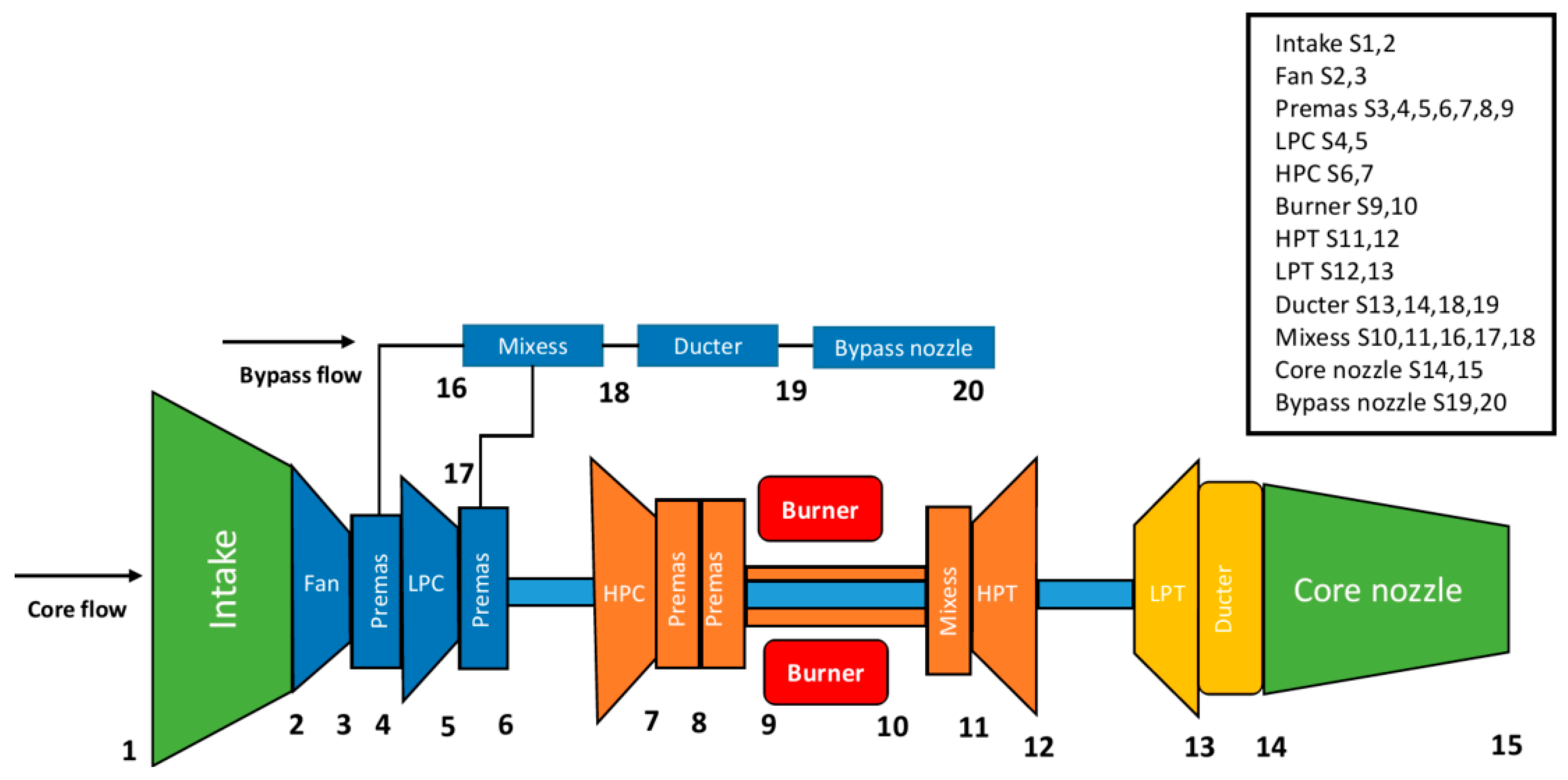
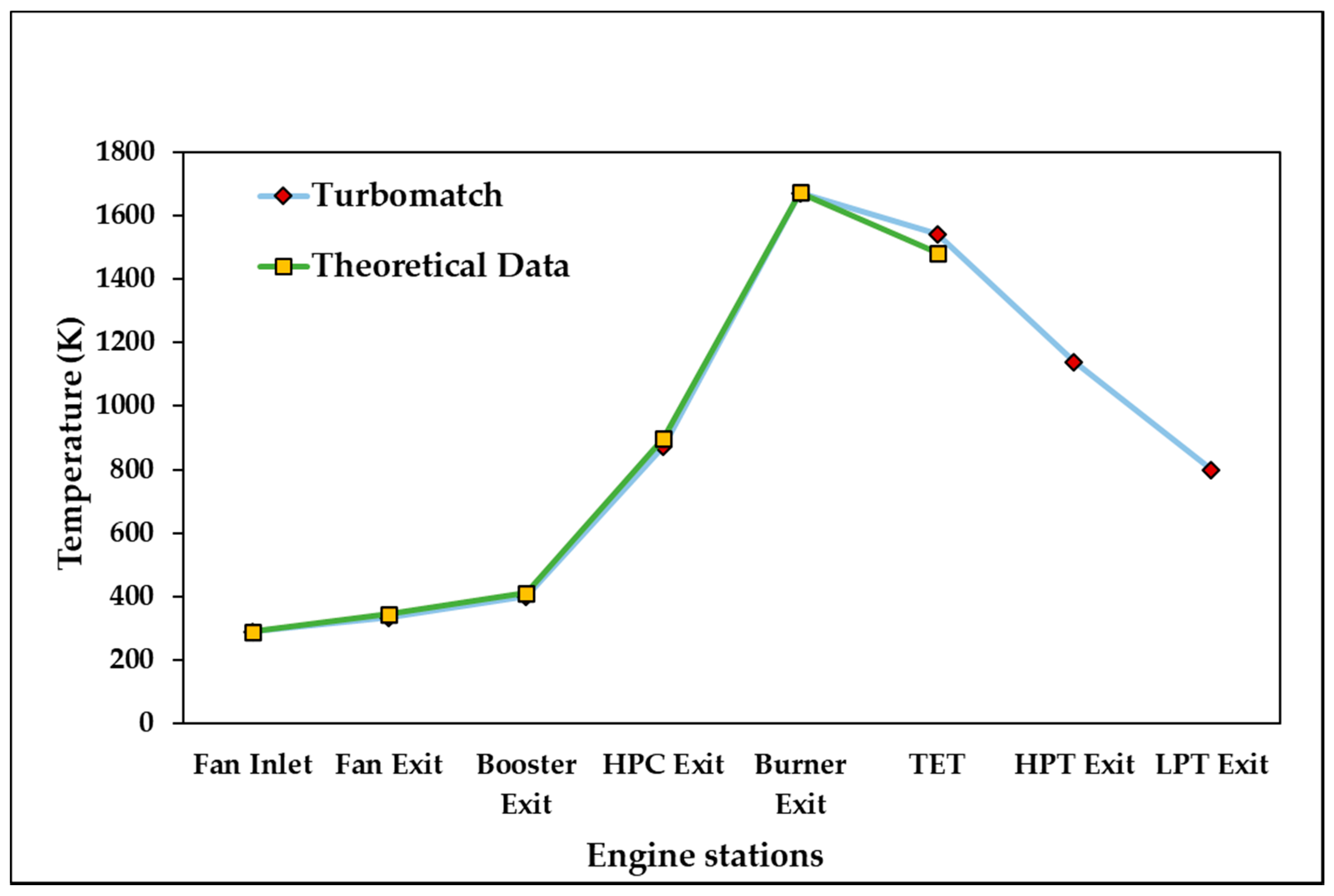
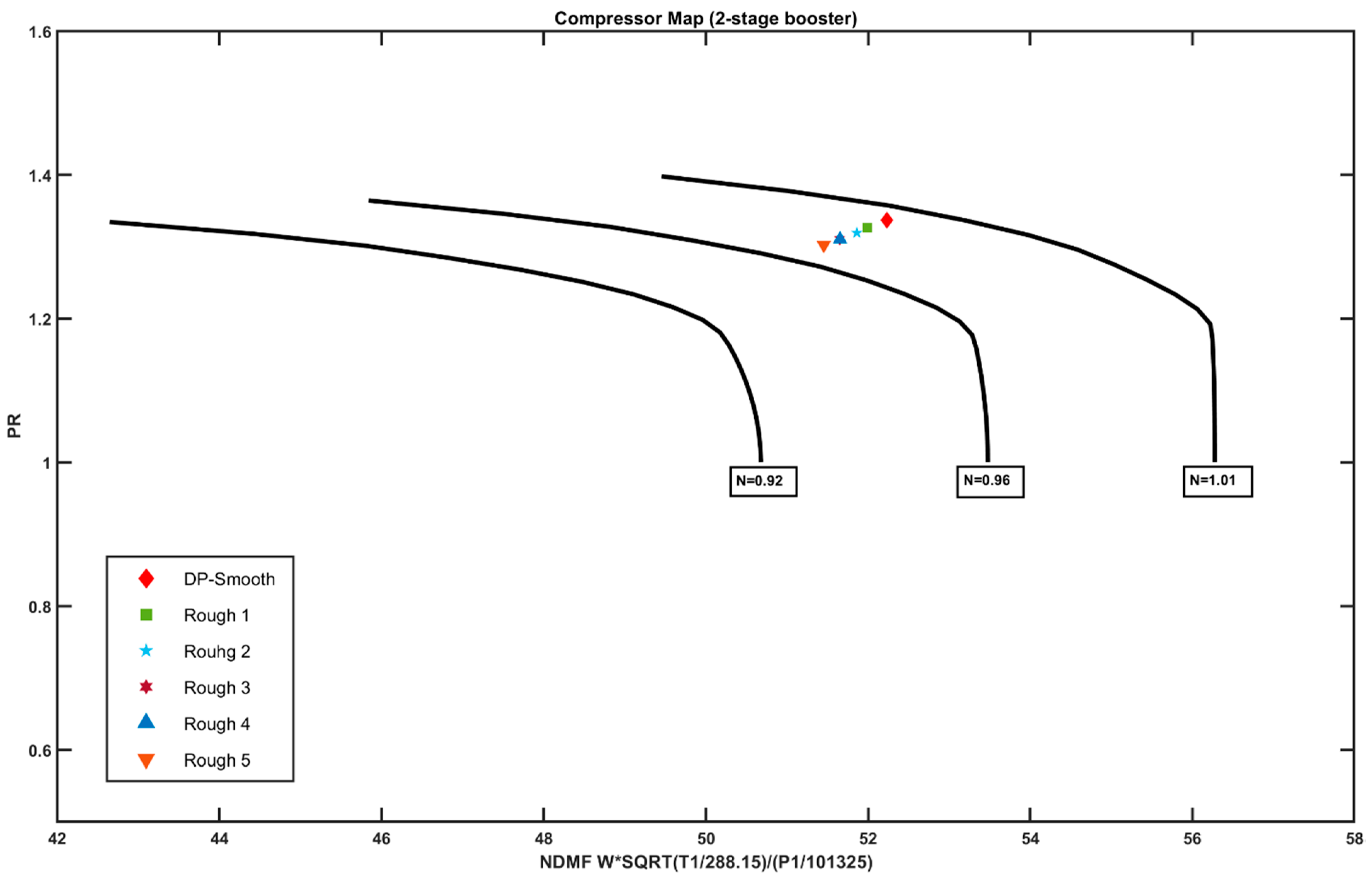
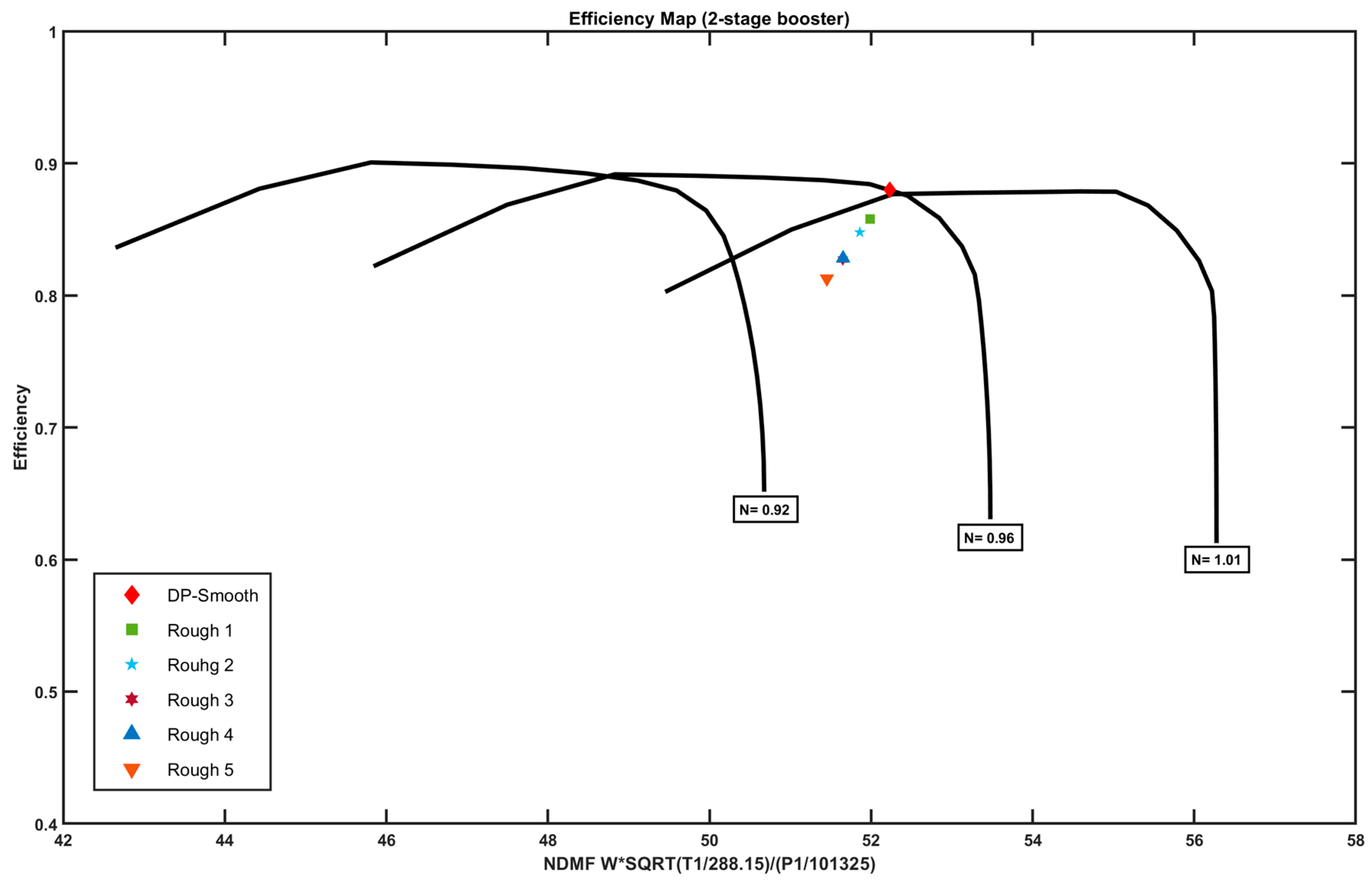
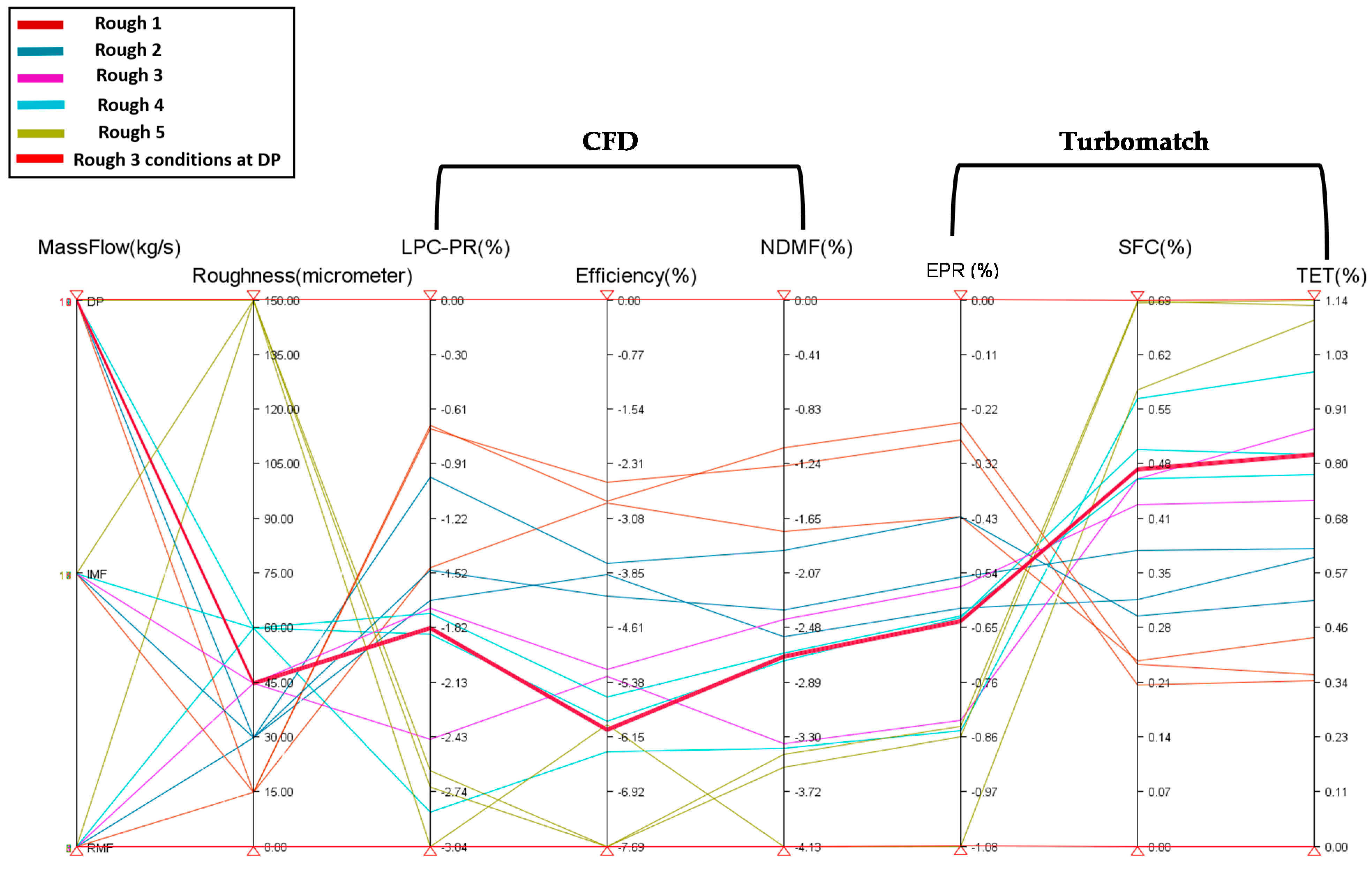
| Number | ks (µm) | Ra (µm) |
|---|---|---|
| Smooth case | - | - |
| Rough 1 | 15 | 2.419 |
| Rough 2 | 30 | 4.838 |
| Rough 3 | 45 | 7.258 |
| Rough 4 | 60 | 9.677 |
| Rough 5 | 150 | 24.193 |
| Items | Unit | Value |
|---|---|---|
| Fan pressure ratio | - | 1.74 |
| Number of fan blades (R1) | - | 24 |
| R1 tip clearance | mm | 1.39 |
| Number of exit guide vanes (EGV) blades | - | 29 |
| Number of inlet guide vanes (IGV) blades | - | 76 |
| Number of second rotor blades (R2) | - | 82 |
| R2 tip clearance | mm | 0.97 |
| Number of stator blades (S2) | - | 102 |
| Number of third rotor blades (R3) | - | 88 |
| R3 tip clearance | mm | 0.86 |
| Number of third stator blades (S3) | - | 110 |
| Mass flow rate (engine) (100% speed-line) | kg/s | 623.73 |
| mass flow rate (LPC) (100% speed-line) | kg/s | 83.05 |
| LPC pressure ratio (PR) (for the four stages) | - | 1.77 |
| LPC PR (for the first two stages) | - | 1.336 |
| Rotational speed for 100% speed-line | r/min | 4215 |
| Parameters | Coarse Mesh | Medium Mesh | Fine Mesh |
|---|---|---|---|
| Number of nodes (all components) | 3.1 M | 4 M | 8 M |
| Polytropic efficiency (SST turbulence model) | 0.95 | 0.96 | 0.96 |
| Simulation time (SST turbulence model) | 4 h and 53 min | 6 h and 35 min | 9 h and 50 min |
| Components | Number of Nodes |
|---|---|
| Fan | 1.6 M |
| Bypass | 417 k |
| IGV | 387 k |
| R2 | 389 k |
| S2 | 357 k |
| R3 | 402 k |
| S3 | 478 k |
| Components | ∅ = PR (with Monotonic Convergence) |
|---|---|
| N1, N2, N3 | 3,106,608, 3,987,820, 7,963,228 |
| 0.92 | |
| 0.80 | |
| 1.28 | |
| 1.30 | |
| 1.31 | |
| P | 3.02 |
| 1.33 | |
| 0.63% | |
| 2.78% | |
| 3.5% |
| Parameter | CFD Results | Reference | Deviation (%) |
|---|---|---|---|
| (kg/s) | 84.7 | 83.1 | 1.8 |
| PR (2-stage booster) | 1.30 | 1.34 | 2.9 |
| at stage 2 exit (K) | 344.2 | 333.0 | 3.2 |
| ηis (2-stage booster) | 0.79 | 0.82 | 3.6 |
| Case | Reduction | ||
|---|---|---|---|
| PR | NDMF | ||
| Smooth | - | - | - |
| Rough 1 | 0.992 | 0.987 | 0.974 |
| Rough 2 | 0.991 | 0.981 | 0.962 |
| Rough 3 | 0.981 | 0.973 | 0.939 |
| Rough 4 | 0.982 | 0.972 | 0.940 |
| Rough 5 | 0.973 | 0.964 | 0.9231 |
| Case | Deviation (%) | (Δ) | |
|---|---|---|---|
| EPR | SFC | TET (K) | |
| Smooth | - | - | - |
| Rough 1 | −0.275 | +0.204 | +5.8 |
| Rough 2 | −0.426 | +0.292 | +8.6 |
| Rough 3 | −0.633 | +0.476 | +13.7 |
| Rough 4 | −0.626 | +0.502 | +13.7 |
| Rough 5 | −0.862 | +0.687 | +19.1 |
Publisher’s Note: MDPI stays neutral with regard to jurisdictional claims in published maps and institutional affiliations. |
© 2021 by the authors. Licensee MDPI, Basel, Switzerland. This article is an open access article distributed under the terms and conditions of the Creative Commons Attribution (CC BY) license (https://creativecommons.org/licenses/by/4.0/).
Share and Cite
Alqallaf, J.; Teixeira, J.A. Blade Roughness Effects on Compressor and Engine Performance—A CFD and Thermodynamic Study. Aerospace 2021, 8, 330. https://doi.org/10.3390/aerospace8110330
Alqallaf J, Teixeira JA. Blade Roughness Effects on Compressor and Engine Performance—A CFD and Thermodynamic Study. Aerospace. 2021; 8(11):330. https://doi.org/10.3390/aerospace8110330
Chicago/Turabian StyleAlqallaf, Jasem, and Joao A. Teixeira. 2021. "Blade Roughness Effects on Compressor and Engine Performance—A CFD and Thermodynamic Study" Aerospace 8, no. 11: 330. https://doi.org/10.3390/aerospace8110330
APA StyleAlqallaf, J., & Teixeira, J. A. (2021). Blade Roughness Effects on Compressor and Engine Performance—A CFD and Thermodynamic Study. Aerospace, 8(11), 330. https://doi.org/10.3390/aerospace8110330






